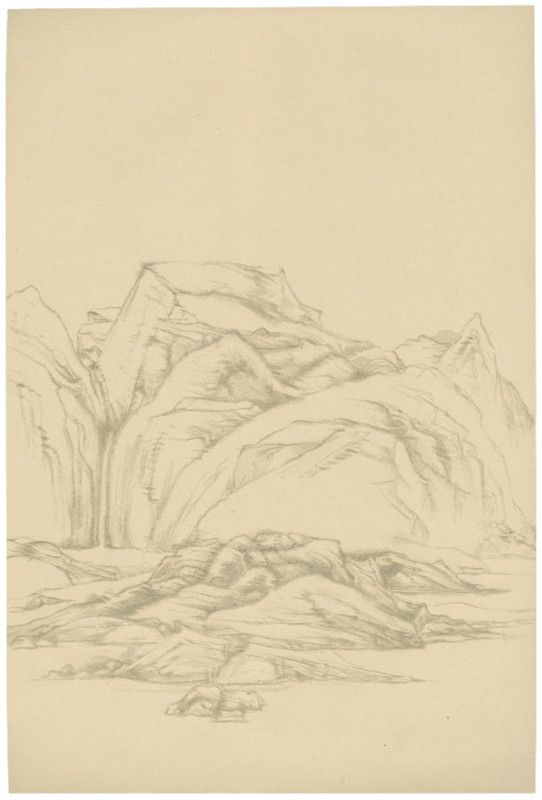Ascan Pinckernelle
11 Jan - 15 Feb 2014

Ascan Pinckernelle
Untitled, 2013
Ink on paper
39.9 x 26.8 cm
(倪瓚 Ní Zàn 1306-1374
Two cottages at the Foot of a Mountain dated 1352)
Untitled, 2013
Ink on paper
39.9 x 26.8 cm
(倪瓚 Ní Zàn 1306-1374
Two cottages at the Foot of a Mountain dated 1352)
ASCAN PINCKERNELLE
11 January - 15 February 2014
Ascan Pinckernelle presents 15 framed Chinese mountain landscapes in his second exhibition at Galerie Gisela Capitain.
All the works allude to extant paintings by various Chinese artists ranging from the Song to the Ming dynasties. Although Pinckernelle takes these as his direct models, he does not copy them in the strict sense of the word. He removes all the accessories of the original visual language, such as buildings, people and colours, and reduces them to a pure mountain motif, thereby setting his paintings off against the original works.
This reduction is reflected in the formats he chooses. Although their vertical alignment is oriented on the Chinese models, they do not otherwise conform to the original format, which was sometimes as much as two meters in height. The mountain landscapes are scaled down, a change of perspective that deliberately creates a distance between them and their original models.
All the pictures should be seen as paintings on paper. They are the outcome not only of a historical study of Chinese painting in general, but also with the painters of the respective images; Pinckernelle has researched their lives in detail and in a certain sense fully empathises with them.
The methodology underlying this exhibition is paradigmatic of Pinckernelle’s approach. The principle of appropriation and the related question of authorship is a key artistic element that repeats itself in another body of work, his architectural images. For him, appropriating imagery always implies isolation. Reducing everything to the mountain motif with its various rock formations allows the original artist’s hand to emerge as clearly as it visualises Pinckernelle’s contemporary artistic intervention.
This engagement with Chinese painting is autobiographically motivated yet at the same time predestined to question ways of seeing and to express the artist’s concerns. These idealized Chinese landscapes, which often illustrate their author’s internal disposition, have a familiar and at the same time alienating effect on us.
Pinckernelle picks up on this ambiguity in his formal presentation. He plays with the Chinese allusions by using the portrait format and centrally framing the images, at the same time breaking them down through his choice of paper, be it wrapping paper or rice paper, or by deciding on his own format, which could even involve the amalgamation of a number of sheets.
Copying was common practice amongst Chinese painters and they imitated, variegated and modified their artistic models. This is reflected in the way the paintings are displayed in their models’ chronological order starting at the gable end in the first room of the exhibition. Works by artists who were friends and mutual influences are hung together and correspond with each other here. For example, paintings based on works by Huang Gongwang, Ni Zan and Cao Zhibo are all displayed on the long wall in the main room.
11 January - 15 February 2014
Ascan Pinckernelle presents 15 framed Chinese mountain landscapes in his second exhibition at Galerie Gisela Capitain.
All the works allude to extant paintings by various Chinese artists ranging from the Song to the Ming dynasties. Although Pinckernelle takes these as his direct models, he does not copy them in the strict sense of the word. He removes all the accessories of the original visual language, such as buildings, people and colours, and reduces them to a pure mountain motif, thereby setting his paintings off against the original works.
This reduction is reflected in the formats he chooses. Although their vertical alignment is oriented on the Chinese models, they do not otherwise conform to the original format, which was sometimes as much as two meters in height. The mountain landscapes are scaled down, a change of perspective that deliberately creates a distance between them and their original models.
All the pictures should be seen as paintings on paper. They are the outcome not only of a historical study of Chinese painting in general, but also with the painters of the respective images; Pinckernelle has researched their lives in detail and in a certain sense fully empathises with them.
The methodology underlying this exhibition is paradigmatic of Pinckernelle’s approach. The principle of appropriation and the related question of authorship is a key artistic element that repeats itself in another body of work, his architectural images. For him, appropriating imagery always implies isolation. Reducing everything to the mountain motif with its various rock formations allows the original artist’s hand to emerge as clearly as it visualises Pinckernelle’s contemporary artistic intervention.
This engagement with Chinese painting is autobiographically motivated yet at the same time predestined to question ways of seeing and to express the artist’s concerns. These idealized Chinese landscapes, which often illustrate their author’s internal disposition, have a familiar and at the same time alienating effect on us.
Pinckernelle picks up on this ambiguity in his formal presentation. He plays with the Chinese allusions by using the portrait format and centrally framing the images, at the same time breaking them down through his choice of paper, be it wrapping paper or rice paper, or by deciding on his own format, which could even involve the amalgamation of a number of sheets.
Copying was common practice amongst Chinese painters and they imitated, variegated and modified their artistic models. This is reflected in the way the paintings are displayed in their models’ chronological order starting at the gable end in the first room of the exhibition. Works by artists who were friends and mutual influences are hung together and correspond with each other here. For example, paintings based on works by Huang Gongwang, Ni Zan and Cao Zhibo are all displayed on the long wall in the main room.
